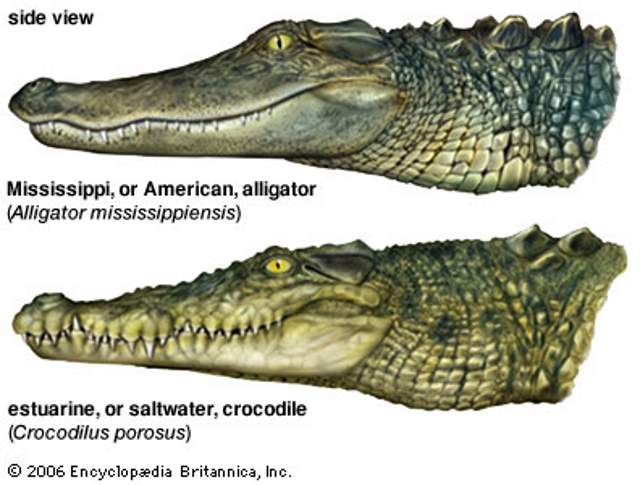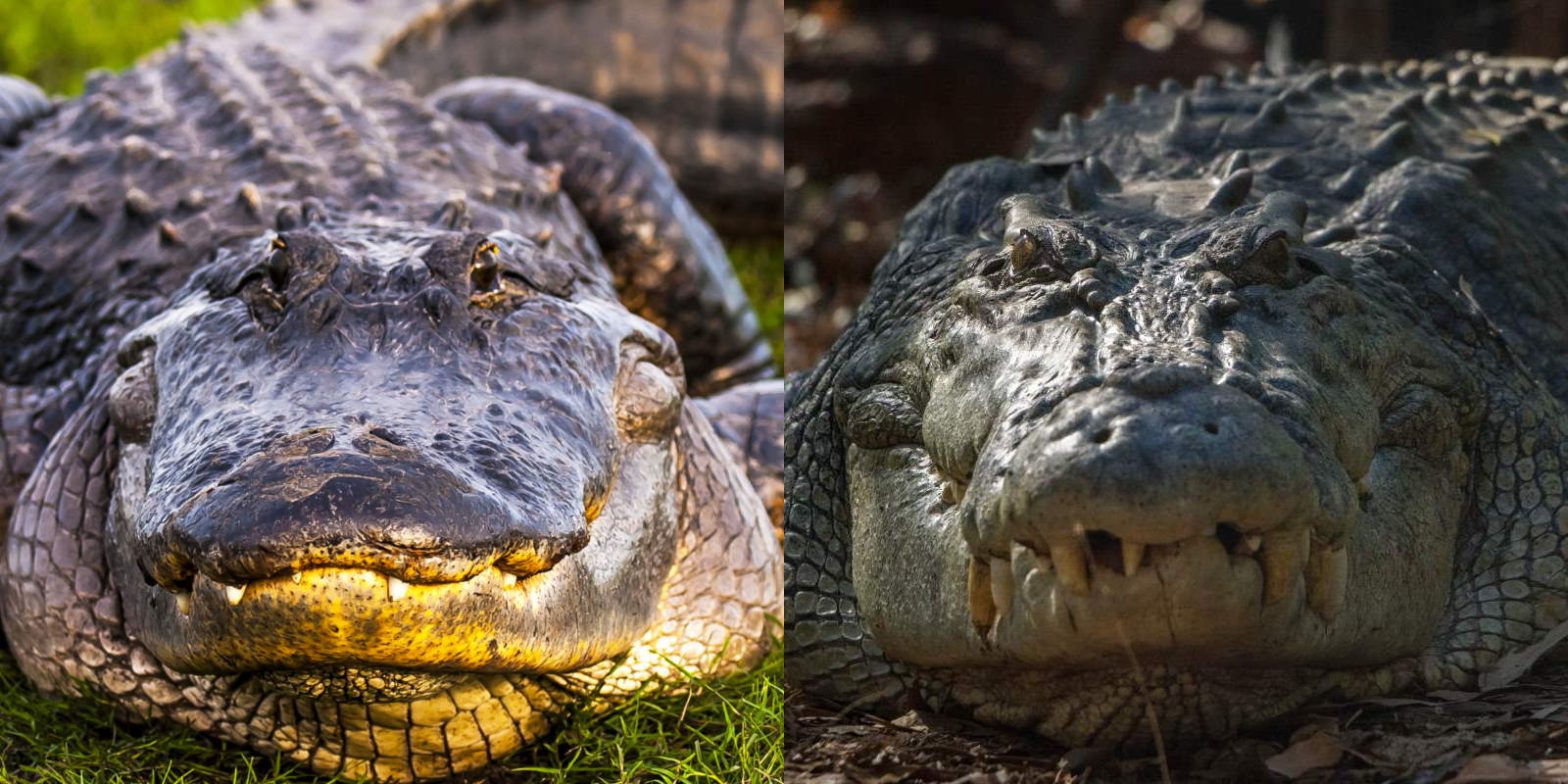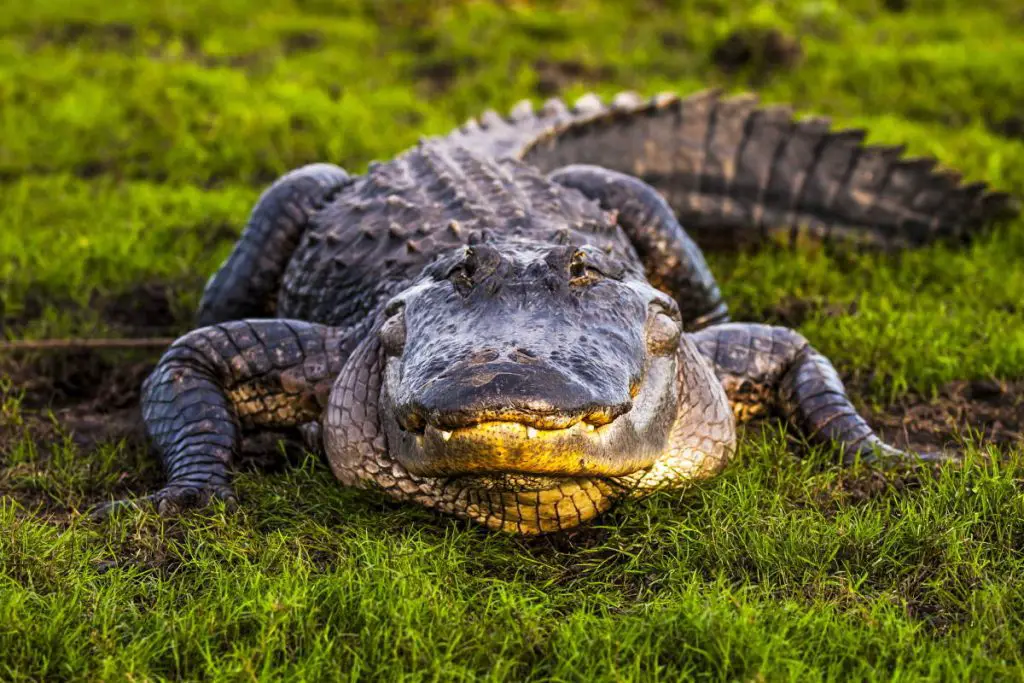Crocodiles and alligators share many similarities since an alligator is also a crocodilian. But, there are also many differences between a crocodile and an alligator. Here are some of them.
What’s the difference between a crocodile and an alligator?
An alligator is also a crocodilian in the genus Alligator of the family Alligatoridae. So the two creatures share many similarities. But what are the real differences between them? This is probably the most frequently asked question when it comes to crocodilians.

The difference between the shape of Crocodile and Alligator heads (jaws)
The shape of the head (jaw) is the most obvious difference between a crocodile and an alligator. Crocodiles have longer, more V-shaped heads than alligators. Look at their noses: alligators (and caimans) have a wide “U”-shaped, rounded snout (like a shovel), whereas crocodiles tend to have longer and more pointed “V”-shaped noses.

The broad snout of alligators is designed for strength, capable of withstanding the stress caused to
Of course, alligators eat softer prey too, but hard-shelled prey are ubiquitous in their environment and it’s a big advantage to be able to eat them. Conversely, the pointed snout of a crocodile looks not quite as strong as the
Crocodile jaws can be thought of as being more generalized – ideal for a wide variety of prey. The full extent of the way jaw shape influences diet isn’t particularly well studied in crocodilians, but it’s obvious that a very thin nose like a
Despite alligator jaws seem more strong, crocodile jaws are stronger. They beat all creatures whose bites have been evaluated, in fact. Paleobiologist Gregory M. Erickson and colleagues put all 23 living crocodilian species through an unprecedented bite test. The “winners” -saltwater crocodiles- slammed their jaws shut with 3,700 pounds per square inch (psi), or 16,460 newtons, of bite force (this is far more powerful than even the strongest bite force of the carnivore land mammals).
And while a 2008 computer model estimated that a 21-foot (6.5-meter) great white shark would produce nearly 4,000 psi (17,790 newtons) of bite force, that figure hasn’t been directly measured. Read the full story on nationalgeographic.com.
Saltwater crocodiles are bigger than alligators
Saltwater crocodiles are the largest reptilians on Earth with the largest properly measured individual (Lolong) at 20 feet 3 in (6.17 meters) from snout-to-tail.
Adult male American alligators measure 3.4 to 4.8 m (11.2 to 15.7 ft) in length. The largest Alligator ever recorded was 19 feet 2 inches (5.84 meters) in length.
The placement of teeth is very different between alligators and crocodiles
In alligators, the upper jaw is wider than the lower jaw and completely overlaps it. Therefore, the teeth in the lower jaw are almost completely hidden when the mouth closes, fitting neatly into small depressions or sockets in the upper jaw.

This is particularly apparent with the large fourth tooth in the lower jaw. In crocodiles, the upper jaw and lower jaw are approximately the same
Therefore, the upper teeth interlock (and “interdigitate”) with the lower teeth when the mouth shuts. As the large fourth tooth in the lower jaw also fits outside the upper jaw, there is a well-defined constriction in the upper jaw behind the nostrils to accommodate it when the mouth is closed. The fourth tooth of a crocodile sticks out when its mouth is closed.
Other differences between a crocodile and an alligator
Alligators strongly favor freshwater while some species of crocodiles live in seawater. Both Alligators and Crocodiles have glands on their tongues that help cope with high salt content in water, only the crocodile gland appears to function, or function effectively. This fact means Crocodiles are far more likely to be found in saltwater than Alligators.
Alligator species, of which there are two, are restricted geographically to the southeast of the United States of America, the American Alligator (Alligator mississippiensis) and the Chinese Alligator (Alligator sinensis) in the Yangtze River in China. Caiman species are found in Central and South America, while the Gharial (Gavialis gangeticus) is native to India.
Crocodile species have a far wider range, living throughout the tropical waters of Africa, Asia the Americas, and Australia. Most people regard crocodiles as more aggressive than alligators, and this is true for some species.
For example, alligators are relatively docile next to saltwater crocodiles, but there are many species with many different kinds of behaviors and temperaments. A general rule that crocodiles are more aggressive than alligators just isn’t possible to make.
But, saltwater crocodiles and Nile crocodiles are definitely more aggressive than alligators. According to Britannica, most incidents did not seem to start with the alligator but rather began with people attempting to pick up, capture, or otherwise handle the animal. Between 2000 and 2007, alligator attacks averaged just under 11 per year in Florida, with a death ratio of less than 10%. Between 1948 and 2005, wildlife officials documented 379 alligator attacks on people, which resulted in 17 deaths.
Contrarily, according to the CrocBITE database, each year, at least hundreds of crocodile attacks on humans occur. In Australia, a quarter of those attacks were fatal, in Malaysia half of the attacks resulted in the victim’s death. Since the records are kept by only Australia and Malaysia, there can be also undocumented attacks.

Related: Largest prehistoric alligators
Sources
- Alligator on Wikipedia
- What’s the difference between a crocodile and an alligator? on Crocodilian.com
- Crocodile & Alligator Differences on ScienceKidz.co.nz
- Moon Landings: All-Time List [1966-2025] - February 2, 2025
- What Is Max-Q and Why Is It Important During Rocket Launches? - January 16, 2025
- Top 10 Tallest Rockets Ever Launched [2025 Update] - January 16, 2025


